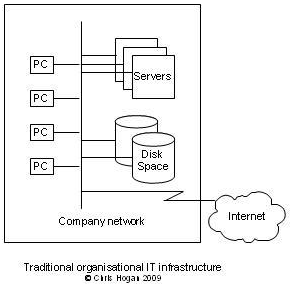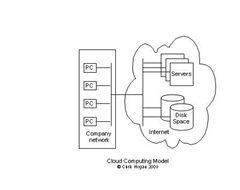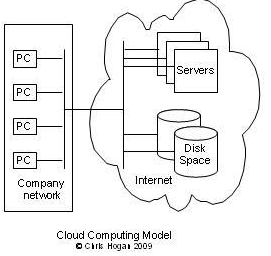Definition: Cloud computing is an umbrella term used to describe
the use of computing services that are hosted on a network (typically the
internet) and used by PCs (or other devices) without having to specify specific
servers or systems.



Different Cloud Computing Variations
This is an example of a cloud computing variant known as software as a Service
(SaaS) where an application and your data are hosted in the cloud. There are
two other major variants, infrastructure as a service (IaaS) and platform as a
service (PaaS).
As the names suggest, these variants offer infrastructure or platforms on the
web that companies pay to use as and when they need them. Companies can buy
time on servers as disk space (IaaS) and deploy their own software and
applications on that rented infrastructure. This was initially know as hardware
as a service (HaaS) but IaaS appears to have displaced that term.
PaaS describes buying something more than IaaS in that software is included in
the offering. A typical PaaS deployment would be workflow or development
platforms which teams use over the internet or a private network to collaborate
on projects. There is often little or no dividing line between PaaS and SaaS.
Supporting Technology for Cloud Computing
The idea of cloud computing has been around for a while, with application
software providers (ASP) first appearing at the beginning of this century. But
it is in recent years that a number of technologies have been developed that
make cloud computing more accessible and workable that it might otherwise be.
Virtualisation is one of those technologies. It allows many instances of an
operating system, or many different operating systems, to run on one server.
This allows providers of cloud computing services to make the best use of their
hardware and tailor it to customer demand, taking virtual servers up and down
and even moving them between physical servers as required. .
Stronger Communications Links Inside and Outside the Cloud
Infiniband is another cloud computing enabling technology, a standard for
connecting high-powered servers and storage arrays. This has allowed the building
of larger server 'farms' in which individual computers can talk to each other
and pass computations between them. Infiniband has enable the spread of grid
computing which has fuelled the spread of cloud computing.
Cloud computing operators need to have strong networks that are laid over the
ordinary internet to be able to provide guarantees of service. This technique
is known as optimised internet overlay and improve the reliability of
communications over the internet.
Business Benefits from Using Cloud Computing
There's no doubt that cloud computing offers significant advantages to
businesses, particularly small businesses and startups. Precious startup capital
can be eked out of the initial years by paying low monthly charges for just the
software and services that a company needs, when they need them. This offers a
startup the same software that multinationals use without having to invest in
an IT infrastructure and IT personnel from the word go.
Users also only need low-power, low-cost PCs because the power and space that
they need for heavyweight applications can be provided by the cloud. Only high
intensity applications like heavy database crunching or video processing need
be done locally.
Possible Disadvantages of Cloud Computing
Many people have concerns about the hosting of company and personal data on
remote servers and there's no way that cloud computing can operate without
strict data privacy agreements and adherence to them. Companies are also
unwilling to have their data on the internet where it may be at risk from
corruption or theft.
There are impacts on company growth and overheads too. Once a company has a
significant number of users on a cloud computing platform they are at risk from
price rises from the hosting companies. Companies may then find that moving
away from a hosted service to their own infrastructure and data is technically
and managerial a significant challenge.
Support from the Big Boys
Whether or not cloud computing is considered to bring benefits or disadvantages
all of the major technology companies in computing have thrown their weight
behind it including Microsoft, IBM, Google, and Amazon.
Copyright © 2011 - All Rights Reserved - Softron.in
Template by Softron Technology